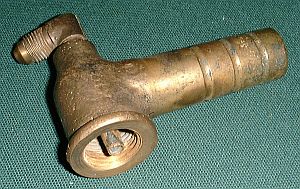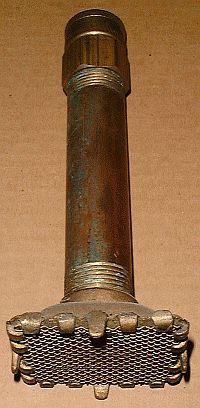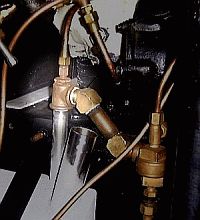|
 The Stanley
siphon works along the same principals as the injectors found on steam
locomotives for forcing water into the boiler against the boiler's pressure.
The photo at the right is of an early Stanley siphon designed for use with a
hose. One end of the siphon (bottom of the photo) is threaded so that
the siphon may be permanently attached to a 3/4" piece of pipe going to the
water tank. The supply hose is slipped over the ringed barb (right in
the photo) while the other end of the hose is placed in a water source (this
end of the hose had a screen assembly to prevent the sucking up of debris).
Steam is applied to a fitting that protrudes through the center of the
siphon to the end where the siphon connects to the 3/4" pipe (you can see
the 1/4" tubing from the steam supply centered in the 3/4" pipe threaded end
of the siphon). The Stanley
siphon works along the same principals as the injectors found on steam
locomotives for forcing water into the boiler against the boiler's pressure.
The photo at the right is of an early Stanley siphon designed for use with a
hose. One end of the siphon (bottom of the photo) is threaded so that
the siphon may be permanently attached to a 3/4" piece of pipe going to the
water tank. The supply hose is slipped over the ringed barb (right in
the photo) while the other end of the hose is placed in a water source (this
end of the hose had a screen assembly to prevent the sucking up of debris).
Steam is applied to a fitting that protrudes through the center of the
siphon to the end where the siphon connects to the 3/4" pipe (you can see
the 1/4" tubing from the steam supply centered in the 3/4" pipe threaded end
of the siphon).
Operation of the steam siphon relies
on the condensing of the steam back into water and the resulting vacuum that
is created. When the steam siphon valve is opened a small amount to
admit steam to the siphon the steam rushes down the 3/4" pipe and into the
water tank (a generous 1-1/2" diameter vent pipe is provided with the water
tank to prevent it from becoming pressurized by the steam). As the
steam rushes down the pipe it pulls air along with it setting up a vacuum in
the pipe which draws makeup air from the hose. The drawing of air from
the hose creates a vacuum in the hose and water is drawn into the hose.
Water is slowly pulled into the hose as the siphon is primed.
 Once the hose has been filled with
water and the water reaches the siphon, the water quickly condenses the
steam and a vacuum is formed in the space once occupied by the steam.
The water quickly fills the space once occupied by the steam and since the
steam was moving at a high velocity due to it being released from the end of
the steam supply tube, the water takes on the moving kinetic energy of the
steam and quickly travels down the 3/4" pipe into the tank. At this
point there is a definite pitch change in the operation of the siphon
signaling that the siphon has been primed and the steam valve can be opened
further to admit a greater quantity of steam. This increased quantity
of steam is not only moving faster but the added volume of steam that can be
condensed by the cooling action of the water allows for very rapid filling
of the water supply tank. If the steam valve is opened too much the
water can not condense the steam fast enough and the siphon will stop
functioning and actually blow water back down the supply hose. Once the hose has been filled with
water and the water reaches the siphon, the water quickly condenses the
steam and a vacuum is formed in the space once occupied by the steam.
The water quickly fills the space once occupied by the steam and since the
steam was moving at a high velocity due to it being released from the end of
the steam supply tube, the water takes on the moving kinetic energy of the
steam and quickly travels down the 3/4" pipe into the tank. At this
point there is a definite pitch change in the operation of the siphon
signaling that the siphon has been primed and the steam valve can be opened
further to admit a greater quantity of steam. This increased quantity
of steam is not only moving faster but the added volume of steam that can be
condensed by the cooling action of the water allows for very rapid filling
of the water supply tank. If the steam valve is opened too much the
water can not condense the steam fast enough and the siphon will stop
functioning and actually blow water back down the supply hose.
How easily a steam siphon will pick
up its prime depends on the length of hose being used and how great the
vertical distance or "lift" is from the intake end of the hose to the
siphon. Generally the steam siphon will easily pick up is prime on a
25' length of rubber hose that is sitting in a water supply no more than 10'
below the level of the car. Often, if the lift is of great distance
the use of a check valve on the suction end of the hose along with
prefilling the hose with water will allow the siphon to pick up its prime
easily. When
placing the supply hose in the source of water it must be placed in such a
way that mud, sediment, stones, and other debris are not drawn into the
water tank (often placing the end in a small coffee can so that the coffee
can serves as a suction receptacle works well). The water drawn in by
the steam siphon must be clean and clear. If muddy water is put in the
supply tank the pumps will transfer it to the boiler where the generation of
steam will leave the mud behind to foul the boiler and shorten it's life.
Additionally grit in the water will damage the seats of the pump check
valves along with quickly plugging up the water tank filter and water system
strainers. |

 The Stanley
siphon works along the same principals as the injectors found on steam
locomotives for forcing water into the boiler against the boiler's pressure.
The photo at the right is of an early Stanley siphon designed for use with a
hose. One end of the siphon (bottom of the photo) is threaded so that
the siphon may be permanently attached to a 3/4" piece of pipe going to the
water tank. The supply hose is slipped over the ringed barb (right in
the photo) while the other end of the hose is placed in a water source (this
end of the hose had a screen assembly to prevent the sucking up of debris).
Steam is applied to a fitting that protrudes through the center of the
siphon to the end where the siphon connects to the 3/4" pipe (you can see
the 1/4" tubing from the steam supply centered in the 3/4" pipe threaded end
of the siphon).
The Stanley
siphon works along the same principals as the injectors found on steam
locomotives for forcing water into the boiler against the boiler's pressure.
The photo at the right is of an early Stanley siphon designed for use with a
hose. One end of the siphon (bottom of the photo) is threaded so that
the siphon may be permanently attached to a 3/4" piece of pipe going to the
water tank. The supply hose is slipped over the ringed barb (right in
the photo) while the other end of the hose is placed in a water source (this
end of the hose had a screen assembly to prevent the sucking up of debris).
Steam is applied to a fitting that protrudes through the center of the
siphon to the end where the siphon connects to the 3/4" pipe (you can see
the 1/4" tubing from the steam supply centered in the 3/4" pipe threaded end
of the siphon). Once the hose has been filled with
water and the water reaches the siphon, the water quickly condenses the
steam and a vacuum is formed in the space once occupied by the steam.
The water quickly fills the space once occupied by the steam and since the
steam was moving at a high velocity due to it being released from the end of
the steam supply tube, the water takes on the moving kinetic energy of the
steam and quickly travels down the 3/4" pipe into the tank. At this
point there is a definite pitch change in the operation of the siphon
signaling that the siphon has been primed and the steam valve can be opened
further to admit a greater quantity of steam. This increased quantity
of steam is not only moving faster but the added volume of steam that can be
condensed by the cooling action of the water allows for very rapid filling
of the water supply tank. If the steam valve is opened too much the
water can not condense the steam fast enough and the siphon will stop
functioning and actually blow water back down the supply hose.
Once the hose has been filled with
water and the water reaches the siphon, the water quickly condenses the
steam and a vacuum is formed in the space once occupied by the steam.
The water quickly fills the space once occupied by the steam and since the
steam was moving at a high velocity due to it being released from the end of
the steam supply tube, the water takes on the moving kinetic energy of the
steam and quickly travels down the 3/4" pipe into the tank. At this
point there is a definite pitch change in the operation of the siphon
signaling that the siphon has been primed and the steam valve can be opened
further to admit a greater quantity of steam. This increased quantity
of steam is not only moving faster but the added volume of steam that can be
condensed by the cooling action of the water allows for very rapid filling
of the water supply tank. If the steam valve is opened too much the
water can not condense the steam fast enough and the siphon will stop
functioning and actually blow water back down the supply hose.